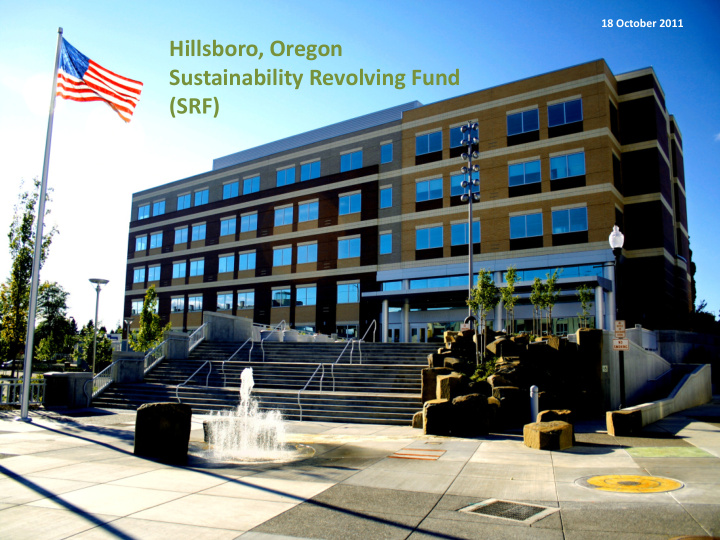



18 October 2011 Hillsboro, Oregon Sustainability Revolving Fund (SRF)
Sustainability Revolving Fund (SRF) Presented to Oregon Municipal Finance Officers Conference Portland, Oregon October 18, 2011 Peter Brandom Sustainability Project Manager peterb@ci.hillsboro.or.us 503-681-6191 150 E Main St Hillsboro, Oregon 97123
Organizational Sustainability Funding • City: 700 employees, 400 vehicles/equipment, 60 facilities Sustainability Drivers: Strategic Plan, Hillsboro 2020 • • Goals, Objectives, Projects • Sustainability Plan
Hillsboro Sustainability Commitment • Goal 8.1: “Assess City operations to identify issues and opportunities, and implement enhanced City-wide sustainable practices (5 Strategic actions)” • Goal 8.2: “Track community Plan sustainability efforts and support expansion of sustainable practices (6 actions)” Hillsboro 2020 Vision • Two new sustainability strategies & Action • 10 new sustainability actions Plan
Funding Evolution • Facilities-related fund FY2010/11 Limited to facilities •
Developing the SRF • Proposed internal RLF to fund small to medium projects Finance not my forte • • Consult the EXPERTS!
Developing the SRF • Describe how RLF works Fund-level best approach • • Develop justification and funding model
Developing the SRF Process • Seed with avoided costs from energy saving projects Established allocation process • • Funds do not expire
SRF Process • Tiered use of funds (small, medium large [$25,000 max]) Review/selection committee • • Quarterly submissions/review • Projects must align and further City goals
Sustainability Goals – 2030 Materials management: Energy and air quality: • Achieve a rate of construction material consumption that • 60% reduced City facility energy consumption per meets internal standards for sustainability square foot (2007 baseline) • 100% of all inputs purchased by the City are sourced • 100% of electricity and natural gas sourced from from sustainable sources or meet internally established renewable sources for City facilities and exterior lighting criteria (e.g., zero waste, zero toxins) where infrastructure technologically and financially feasible • 80% reduction in greenhouse gas emissions; 100% of • Zero toxic emissions remaining emissions offset (2007 baseline) • 100% recycling of waste from City operations • 80% production of energy for City facilities from renewable energy sources • Zero construction and maintenance waste (no waste from construction and maintenance activities is sent to • 100% fossil fuel-free staff vehicles and 40% reduction landfill). May be accomplished via public/private for other exempt vehicles (non-passenger emergency partnerships response, etc.) [Based on available technologies and cost effectiveness] (2007 baseline) Policy: • All City facilities zero net energy consumption, if • 100% of City development investments meet a standard feasible based on Return on Investment (ROI) or set for sustainable development, and City promotes and cost/benefit analysis encourages sustainable development by others Natural Resources: • 100% of applicable City policies incorporate the • 25% reduction in water consumption by City principles of sustainability facilities against established baseline (including re- use and other measures) (2007 baseline) • All city facilities constructed or renovated shall meet current Leadership in Energy and Environmental Design (LEED) standards or better, unless cost prohibitive based on Return on Investment (ROI) or cost/benefit analysis
Thank you It is a journey, not a destination… Credit: Washington County Museum and Historical Society
Recommend
More recommend